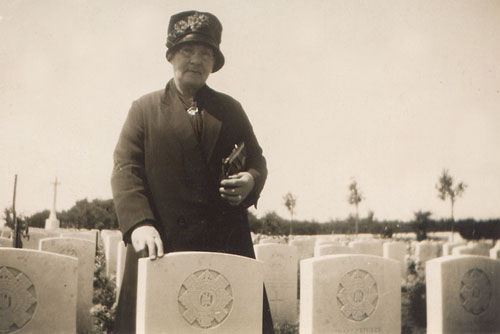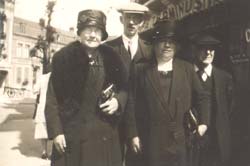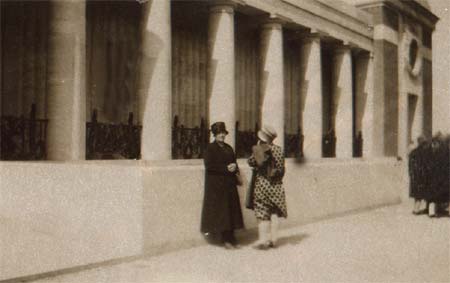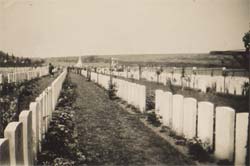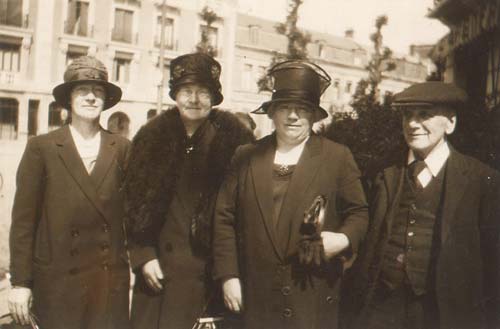NORTH
PILGRIMS IN FRANCE
Widows and Mothers visit Relatives' Graves
TOUCHING
SCENES
From our own Correspondent
Sixty
North-East pilgrims, drawn principally from Aberdeen, but
including a number also from Elgin and certain other centres,
have returned home from the war areas of France after visiting
the graves of relatives who lie buried in British cemeteries
there.
The
most gratifying feature of the pilgrimage was the fact that
every one of the 60 were able to see the graves of their loved
ones, though, in some cases they went without knowing where
the graves were situated. The records available, however,
are so complete that they were able to trace the particular
cemetery they desired to visit.
The
pilgrimage produced many touching scenes when widows and mothers
had their fondest wish fulfilled in being at last able to
kneel before the graves of husband or son.
For
the greater part of the time the party were stationed at Arras,
later going on to Ypres, where they remained until the time
came for the return home. Various cemeteries were visited,
and the pilgrims were able to read the names of their dead
on the great memorial at Menin Gate and at other memorials.
Many places of interest were seen, and the week was altogether
a memorable one for everyone.
It was
conducted by Mr A B McLeod, the British Legion secretary for
Aberdeen, who was assisted by other officials of the Legion.
|
A Pilgrims
Description
One of these, whom I saw on his return to Aberdeen, related
to me the incidents of the tour. "All the arrangements
were in the hands of the Legion, " my informant said,
"and most of the pilgrims were women-folk who were going
to visit the graves of husbands or sons". It was a solemn
pilgrimage, as you can imagine, for to these women the act
of visiting the spot where their loved ones lay was a sacred
thing. It was also, many of them told me, a source of real
inward satisfaction, and it set their hearts and minds at
rest. It has been their greatest wish to visit the graves,
and now that they have been able to do so they are content.
"The
pilgrims also derived great comfort from the beautiful way
in which the various cemetries are kept. When we were there
flowers of every kind were in full bloom, and everything was
neat and tidy. I understand that each 1000 graves have a British
ex-Serviceman in charge of them, and in this way each grave
gets equally good attention".
"During
our stay at Arras the time was mostly spent in visiting the
graves of relatives buried in the cemetries there, while we
also went to Beaumont Hamel and Newfoundland Park. At the
latter place is situated the memorial to the 51st Highland
Division while trenches are also to be seen in the state in
which they were at the end of the war". "At the
Vimy Ridge we saw the famous Grange Tunnel, built by the Canadians,
which stretches for over twenty miles in all directions beneath
the surface of the earth.
The
"Last Post"
"Going on to Ypres, we proceeded to the great Menin Gate
memorial, where we held a short
|
service,
which was conducted by Mr Middleton, one of the Elgin pilgrims.
Mr Middleton carried throught the service in a most impressive
manner, and when it was over a wreath of poppies was placed
below the panel which bears the names of Gordon Highlanders
who have no known grave".
"The
party later visited most of the points of interest on the
Ypres Salient - Hill 60, St Julien, and other places - and
at nine o'clock at night the great majority returned again
to the Menin Gate to hear "Last Post" sounded. Every
night, on the stroke of nine, buglers of the British Army
sound this call in memory of the dead".
"A
number of the pilgrims went also to the cemetery at Tyne Cot
to ses the graves of their relatives. This is the biggest
cemetery containing British dead in the world. Over 11,000
lie buried there, but the French have a bigger cemetery still
at Notre Dame Laurante, which we visited on our way from Arras
to Ypres, there are 100,000 French sGraves".
The
day before we were due to return was spent by most in going
to Ostend, for by this time the pilgrimage was over. Our journey
home was a very pleasant one, and we all came back very satisfied
with everything that we had seen. Probably a number of mothers
and widows who were with us will never have another opportunity
to revisit the cemeteries, but they are now content in the
knowledge that they have been able to visit the graves and
that they are being given every care and attention".
This account
appeared in the Press and Journal
following the visit.
|
